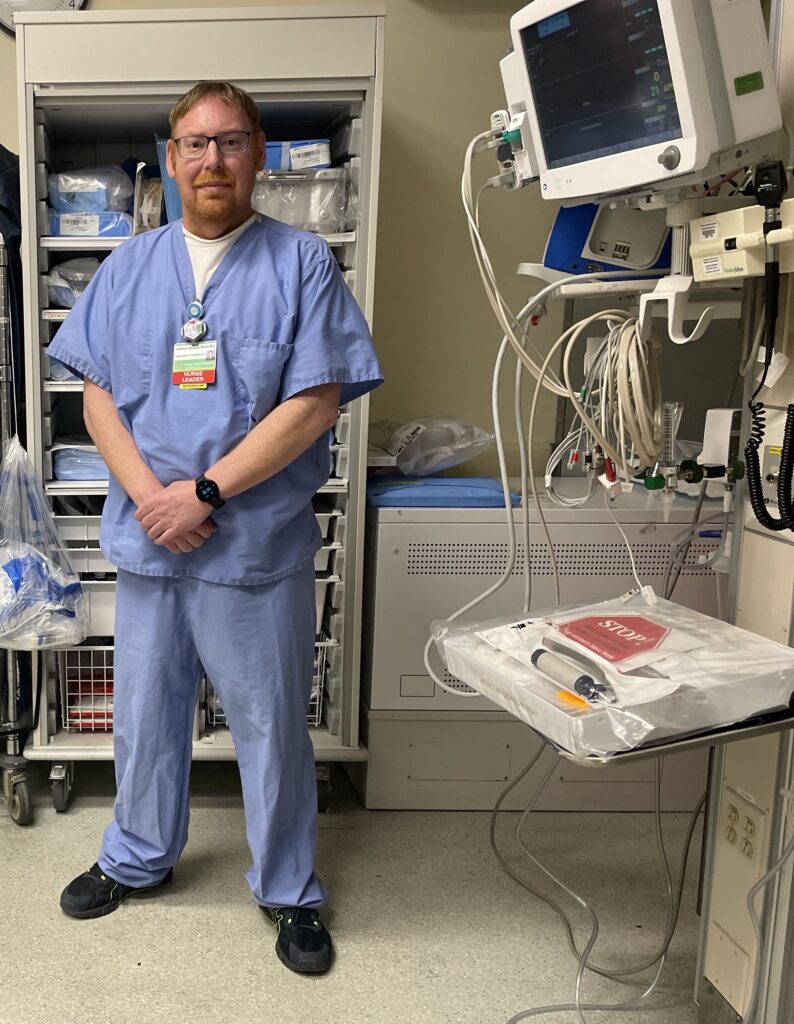A sore throat shouldn’t kill someone. But in 2017 that’s what happened to Skip and Tara Cirella’s 16-year-old daughter Gianna. On a Thursday, Gianna developed a sore throat and felt ill during soccer practice at Toll Gate High School in Warwick. Over the weekend, her mother took her to a walk-in clinic, where she received antibiotics. On Monday, Skip took Gianna to her pediatrician, who was so alarmed she called an ambulance. At Hasbro Children’s Hospital, doctors quickly diagnosed Gianna with double pneumonia and sepsis. Although the Hasbro Pediatric Intensive Care Unit [PICU] team tried for more than two weeks to save her, Gianna’s family made the wrenching decision to let her die in peace.

“When they first brought Gianna to the PICU, she said, ‘Mommy, please take me home.’ I held her tight, and I said, they’re going to make you better, and I’m going to take you home, I promise,” Tara says. “When we knew that Gianna was not going to survive, before we let her go, I told her I would never break a promise again. I promised that I was going to change this.”
Tara and Skip founded the Gianna Cirella Memorial Fund to honor their daughter’s memory and improve sepsis awareness and outcomes. In 2022, the Fund donated $30,000 to support Hasbro’s sepsis research, provided two $3,000 college scholarships to Toll Gate seniors, and provided financial support to local families affected by sepsis.
“Sepsis is the leading cause of deaths in hospitals, and the most common cause of readmissions,” says Dr. Mitchell Levy, Systemwide Director of Critical Care Medicine at Lifespan Health System. Each year 350,000 American adults die from sepsis—more than breast, lung, and prostate cancer combined. And about 5,000 American children die annually from sepsis—more than the number who die of cancer.

Sepsis develops when the immune system overreacts to an infection. At first the body mounts a protective inflammatory response, enabling immune system cells to attack bacteria, viruses, and other pathogens. But when this targeted warfare spins out of control, inflammation becomes widespread. Blood pressure falls, starving vital organs of oxygen. The kidneys, lungs, and brain may fail.
“Sepsis is a medical emergency,” says Levy, “just like a heart attack, stroke, or trauma.”
A big challenge with sepsis is diagnosing it. “If someone comes into the ER with chest pain, we can order an electrocardiogram, or test the blood for enzymes released by damaged heart muscle,” Levy says. “There’s no definitive test for sepsis. We still rely on a set of clinical symptoms to diagnose it.”
Lifespan follows guidelines for management of sepsis known as “sepsis bundles.” To determine how quickly treatment should take place to improve outcomes, Levy is leading the $3.2 million National Institutes of Health-funded AIMS study comparing the current standard of care for sepsis in adults, known as the three-hour bundle, against a one-hour bundle. Both involve the same steps.
“At triage, we evaluate the patient and start the documentation process,” explains Andrew Buksar, a long-time staff nurse at the Rhode Island Hospital emergency department who is now its clinical educator, involved in sepsis care improvement efforts. “As we enter data into the electronic medical record, if the patient meets two or more SIRS criteria, such as increased heart rate, low blood pressure, increased respiratory rate, or increased temperature, an alert pops up. That provides a cue for the triage nurse to stop and think about whether this could be sepsis.” If the nurse decides it might be, the next step is to activate code sepsis.

“Once code sepsis is called, the people assigned respond,” Buksar says. “We kind of descend on the patient.” A physician examines the patient, makes a diagnosis, and starts the appropriate orders. The ER charge nurse arrives to coordinate response by other nurses.
“It’s all this feverish work to get the interventions started,” Buksar says. “Fluid administration, antibiotic administration. Blood pressure medications if necessary. We get those three elements of the sepsis bundle started as quickly as possible because we know that improves outcomes. And during that time, we’re also working with the flow team to immediately get the patient a bed, because they need prompt and continuing treatment.”
Lisa Letourneau, a nurse at Rhode Island Hospital for 36 years (19 of them in the medical intensive care unit), explains what happens next.
“Once we get a head’s up from the ER that they are sending a patient with sepsis to the MICU, we do a pre-assessment,” she says. “We go into the patient’s chart to find out what brought them to the hospital. We look at key lab values.”
They also talk with an ER nurse. “It’s very important for us to know how much fluid the patient has received and what their urine output is,” Letourneau says. “We’re trying to get an idea of their kidney status because that is usually the first system to take a hit. And then what meds they’re on to support their blood pressure.”

Once the patient arrives, a doctor and nurse develop a plan based on the hospital’s sepsis protocol. “Our nurses have great communication with residents, fellows, and attendings,” Letourneau says. “We say, ‘what’s the goal for the patient, what are the blood pressure goals, what kind of blood work are we doing, what are we monitoring?’ And we make a four-hour plan. A nurse does a head-to-toe assessment every four hours. We look at urine output, blood counts, oxygen status. If we see certain signs that worry us, we alert the doctor. It’s constant: Lab work, treatment, results back, reevaluation.”
A major challenge is maintaining blood pressure at the desired levels, so that the patient’s organs receive oxygen. “It’s a fight for organ life up here,” Letourneau says. “Once severe sepsis starts, once you get on that train, it’s hard to put brakes on it.”
At Hasbro, electronic alerts are in place not only in the ER but also in the Tomorrow Fund Clinic, which treats children with cancer and other life-threatening illnesses. “Sepsis occurs in children much more frequently in high-risk populations, such as those who are immune compromised, or children with cancer receiving chemotherapy,” says Dr. Susan Duffy, a pediatric emergency medicine physician at Hasbro. “They also have the highest mortality rate from sepsis.”
To improve care, Hasbro is participating in a national pediatric quality collaborative organized by the Children’s Hospital Association. “We submit our sepsis data and share best practices,” Duffy says.
In 2022, Hasbro treated 121 inpatients for sepsis. “Many more children at risk for sepsis were treated in the inpatient and emergency settings and discharged,” Duffy says. The vast majority survived. “Children are generally healthy and have a lot of reserves, the ability to fight illness,” Duffy says. “The challenge is recognizing sepsis early and differentiating it from routine illness.”

As a teaching hospital, Hasbro incorporates sepsis education into its training programs. “We have also partnered with the Gianna Cirella Memorial Fund to improve community education efforts,” Duffy says. “We are currently working on a program that involves outreach to community emergency departments, to improve their recognition of sepsis using simulations and educational toolkits.”
But Duffy says it’s also important to educate families. “I think one of the most critical things I do when I care for children in the emergency department is to make sure families receive clear discharge instructions: ‘This is what to expect as a child recovers from routine illness. These are signs of more serious illness. Don’t sit at home if you see them, seek care again.’ ”
About 40% of children who survive develop long-term disabilities as a result of sepsis and its treatment. Because many involve the kidneys, Duffy is leading the Hasbro portion of the PRoMPT BOLUS study comparing electrolyte-containing “balanced” fluids with normal saline. “Balanced fluid preserves renal function in adults,” says Duffy. “This the first clinical trial to determine whether it benefits children as well.”
To tackle the ultimate goal—finding a way to diagnose sepsis faster—Levy is collaborating with Dr. Sean Monaghan, a trauma and critical care surgeon at Rhode Island Hospital, who is leading a nearly $2 million NIH study to determine whether deep RNA sequencing can help.
“For every hour delay in treating a patient with sepsis, mortality increases by 7%,” Monaghan says. “We don’t have days, we have hours to get it right for these patients.”
When a patient arrives in the ER with possible sepsis, a doctor orders a blood culture to determine what is causing the infection. “We might get preliminary results in a day, but final results don’t come back for three days,” Monaghan says. “What I’m trying to do is come up with a way to quickly diagnose the infection that is causing sepsis.”

During sequencing, the patient’s blood sample is analyzed for RNA, which carries genetic instructions that enable cells to function.
“With deep RNA sequencing, we get 100 million data points,” Monaghan says. “The first step is to take those pieces of RNA and map them against the human genome.” About 60% to 80% of the data points are such “mapped” reads, which provide a big-picture look at the genes being activated and how sepsis is affecting the body. But Monaghan says the remaining “unmapped” reads are also important because they provide clues about the infectious pathogens.
Because Monaghan sends the blood samples to an outside sequencing company, it currently takes four weeks to get results. “Nothing at this point is close to fast enough for clinical care,” Monaghan says. But “if we can translate some of this work into a PCR test, like the one used to diagnose Covid-19, we might be able to get the result back in four hours. That’s important because if we can identify the exact pathogen, we can make sure we’re giving the right antibiotic.”
To ensure that every healthcare facility in Rhode Island follows evidence-based sepsis protocols, Tara Cirella has been working with other patient advocates to pass legislation (H5869 in the House and S0283 in the Senate) modeled after a law in New York known as “Rory’s regulations.” The law honors the memory of Rory Staunton, a 12-year-old who died of sepsis after doctors failed to recognize the severity of his infection and treat it appropriately.
Levy collaborated on two studies—one in adults published in the New England Journal of Medicine and another in children published in the Journal of the American Medical Association—which both concluded that protocol adherence in New York saved lives. “The published literature consistently shows if you’re compliant with these protocols,” Levy says, “more people survive.”
Because people of color are more likely to die from sepsis than white people, an ongoing challenge is to reduce racial disparities in care. Levy and Dr. Keith Corl, an emergency medicine physician at Rhode Island Hospital, collaborated with Dr. Amal Trivedi, a professor at the Brown University School of Public Health, to evaluate whether the New York regulations had any effect on racial disparities. In a paper published in Health Affairs, they found that while protocol adherence improved outcomes for all racial and ethnic groups, white patients experienced greater improvement than black patients. “The protocols still work,” Levy says, “but hospitals that take care of a higher percentage of black patients may have fewer resources to implement them.”
Although challenges remain, Tara Cirella is determined that Rhode Island enact its own protocol mandate.
“Gianna was just a kid, and there was potential for her to be saved,” Tara says. “The reason she wasn’t was that the people she saw prior to being wheeled into Hasbro did not know she had sepsis. It’s unacceptable if you bring your child to a medical facility to get them help, and they don’t have knowledge to do so.”
Tara promised Gianna she would change things.
It’s a promise she intends to keep.
For more information:






